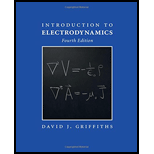
Introduction to Electrodynamics
4th Edition
ISBN: 9781108420419
Author: David J. Griffiths
Publisher: Cambridge University Press
expand_more
expand_more
format_list_bulleted
Question
Chapter 1.6, Problem 1.64P
(a)
To determine
To prove:
To determine
To show:
(c)
To determine
To show:
(d)
To determine
To check: The integral of
Expert Solution & Answer
Want to see the full answer?
Check out a sample textbook solution
Students have asked these similar questions
I have been able to do this with derivatives but I can't figure out how to do this with definite integrals
Let G denote the universal gravitational constant and let M and m denote masses a distance r apart. (a) According to Newton’s Law of Universal Gravitation, M and m attract each other with a force of magnitude _____ . (b) If r is the radius vector from M to m, then the force of attraction that mass M exerts on mass m is ______ .
Let f(x)= 4xex - sin(5x). Find the third derivative of this function.
Note ex is denoted as e^x below.
Select one:
(12+4x^3)e^x + 125sin(5x)
12e^x + 125cos(5x)
not in the list
(12+4x)e^x + 125cos(5x)
(8+4x)e^x + 25sin(5x)
Chapter 1 Solutions
Introduction to Electrodynamics
Ch. 1.1 - Using the definitions in Eqs. 1.1 and 1.4, and...Ch. 1.1 - Prob. 1.2PCh. 1.1 - Prob. 1.3PCh. 1.1 - Prob. 1.4PCh. 1.1 - Prob. 1.5PCh. 1.1 - Prob. 1.6PCh. 1.1 - Prob. 1.7PCh. 1.1 - Prob. 1.8PCh. 1.1 - Prob. 1.9PCh. 1.1 - Prob. 1.10P
Ch. 1.2 - Prob. 1.11PCh. 1.2 - The height of a certain hill (in feet) is given by...Ch. 1.2 - Prob. 1.13PCh. 1.2 - Prob. 1.14PCh. 1.2 - Prob. 1.15PCh. 1.2 - Prob. 1.16PCh. 1.2 - Prob. 1.17PCh. 1.2 - Prob. 1.18PCh. 1.2 - Prob. 1.19PCh. 1.2 - Prob. 1.20PCh. 1.2 - Prob. 1.21PCh. 1.2 - Prob. 1.22PCh. 1.2 - Prob. 1.23PCh. 1.2 - Prob. 1.24PCh. 1.2 - Prob. 1.25PCh. 1.2 - Prob. 1.26PCh. 1.2 - Prob. 1.27PCh. 1.2 - Prob. 1.28PCh. 1.3 - Prob. 1.29PCh. 1.3 - Prob. 1.30PCh. 1.3 - Prob. 1.31PCh. 1.3 - Prob. 1.32PCh. 1.3 - Prob. 1.33PCh. 1.3 - Prob. 1.34PCh. 1.3 - Prob. 1.35PCh. 1.3 - Prob. 1.36PCh. 1.4 - Prob. 1.37PCh. 1.4 - Express the unit vectors in terms of (that is,...Ch. 1.4 - Prob. 1.39PCh. 1.4 - Prob. 1.40PCh. 1.4 - Prob. 1.41PCh. 1.4 - Prob. 1.42PCh. 1.4 - Prob. 1.43PCh. 1.5 - Evaluate the following integrals:
(a)
(b)
(c)...Ch. 1.5 - Prob. 1.45PCh. 1.5 - (a) Show that .
[Hint: Use integration by...Ch. 1.5 - Prob. 1.47PCh. 1.5 - Prob. 1.48PCh. 1.5 - Prob. 1.49PCh. 1.6 - (a) Let and . Calculate the divergence and curl...Ch. 1.6 - Prob. 1.51PCh. 1.6 - Prob. 1.52PCh. 1.6 - Prob. 1.53PCh. 1.6 - Prob. 1.54PCh. 1.6 - Prob. 1.55PCh. 1.6 - Prob. 1.56PCh. 1.6 - Prob. 1.57PCh. 1.6 - Prob. 1.58PCh. 1.6 - Prob. 1.59PCh. 1.6 - Prob. 1.60PCh. 1.6 - Prob. 1.61PCh. 1.6 - Prob. 1.62PCh. 1.6 - Prob. 1.63PCh. 1.6 - Prob. 1.64P
Knowledge Booster
Similar questions
- Verify that vp=2kBTm.`arrow_forwardFor any arbitrary vectors u, v and w, prove thatarrow_forwardConsider a particle of spin s = 3/2. (a) Find the matrices representing the operators S^ x , S^ y ,S^ z , ^ Sx 2 and ^ S y 2 within the basis of ^ S 2 and S^ z (b) Find the energy levels of this particle when its Hamiltonian is given by ^H= ϵ 0 h 2 ( Sx 2−S y 2 )− ϵ 0 h ( S^ Z ) where ϵ 0 is a constant having the dimensions of energy. Are these levels degenerate? (c) If the system was initially in an eigenstate Ψ0=( 1 0 0 0) , find the state of the system at timearrow_forward
- Write the matrices which produce a rotation θ about the x axis, or that rotation combined with a reflection through the (y,z) plane. [Compare (7.18) and (7.19) for rotation about the z axis.]arrow_forwardFind the equations of motion for the LagrangianL = eγt(mq˙2/2 − kq2/2)How would you describe the system? Are there any constants of motion?Suppose a point transformation is made of the forms = eγt/2q.What is the effective Lagrangian in terms of s? Find the equation of motion for s. What do these results say about the conserved quantities for the system?arrow_forwardGo back to question 6 but this time assume uk=0.2. a) How much time elapses before the block reaches its maximum height up the plane? b) How much time elapses from the point it reaches maximum height up the plaane to the point where it was launched?arrow_forward
- Demonstrate that in an electromagnetic field, the gauge transformation transfers the L to an equivalent Lagrangian L', where L' = L+ dFG,1 and F(q, t) is a function of generalised coordinates (q:) and time t. Calculate the generalised momentum and Hamiltonian of the charged particle travelling in an electromagnetic field using the aforementioned Lagrangian.arrow_forwardThe figure shows two railway cars with a buffer spring. We want to investigate the transfer of momentum that occurs after car 1 with initial velocity v0 impacts car 2 at rest. The differential equation is given below. Show that the eigenvalues of the coefficient matrix A are λ1=0 and λ2=−c1−c2, with associated eigenvectors v1= 1 1 T and v2= c1 −c2 T. x′′= −c1 c1 c2 −c2 x with ci=k /mi for i=1, 2 The coefficient matrix A is .arrow_forward
arrow_back_ios
arrow_forward_ios
Recommended textbooks for you
 Classical Dynamics of Particles and SystemsPhysicsISBN:9780534408961Author:Stephen T. Thornton, Jerry B. MarionPublisher:Cengage Learning
Classical Dynamics of Particles and SystemsPhysicsISBN:9780534408961Author:Stephen T. Thornton, Jerry B. MarionPublisher:Cengage Learning

Classical Dynamics of Particles and Systems
Physics
ISBN:9780534408961
Author:Stephen T. Thornton, Jerry B. Marion
Publisher:Cengage Learning
